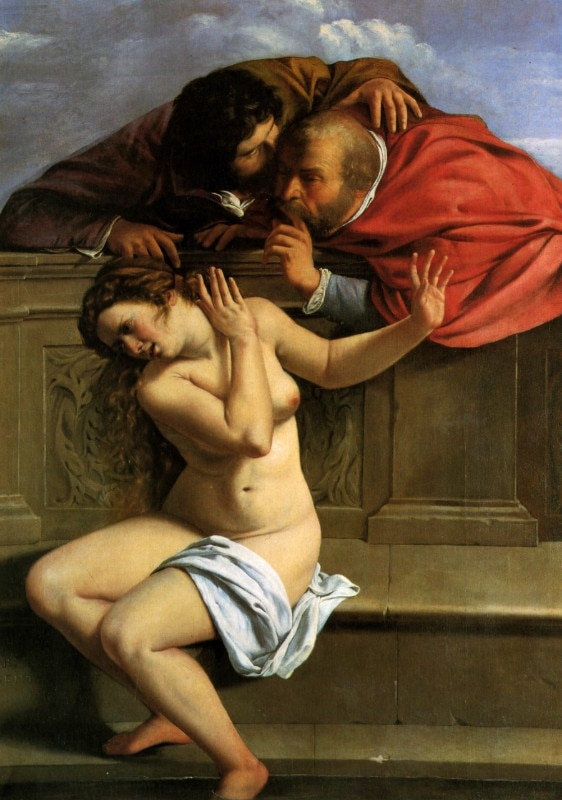The list of victims would be long, almost endless. Women killed by partners, boyfriends, husbands, or brothers. Insane jealousy, ridiculous envy, but above all, possession.
Possession!
The mere thought of being able to possess someone makes one shudder. What nonsense.
Unfortunately, the long list of femicides and violence starts from ancient times. We find them in the Old Testament, in the events of the Roman Empire, ancient stories that never seem to change their course.
Artemisia Gentileschi is undoubtedly an artistic icon in the battle against violence against women. She was a Roman painter of the Caravaggesque school, a leading figure in the 17th-century painting, excelling in a male-dominated environment.
In 1611, Artemisia was raped by Agostino Tassi – an artist associated with her father Orazio’s studio.
The incident was reported to the Holy Office, and the trial caused a sensation. The victimized painter was transformed into a lascivious woman who supposedly seduced the unfortunate Tassi. She endured torture, accusations, and mockery.
Ultimately, Tassi was convicted by the judges of the Papal State. He was sentenced to five years of exile, though he served only a few months. Artemisia was forced to marry Pierantonio Di Vincenzo Stiattesi – a relatively insignificant Florentine painter. Therefore, she moved to Florence experiencing an unwanted shotgun wedding.
Thus began her public protest, her manifestos against Tassi, against the violence she endured, and she retaliated through a painting of extraordinary beauty – Judith Slaying Holofernes.
In this raw and violent scene, Judith, with a face full of pleasure suggesting revenge, beheads Holofernes. The gesture is proud, powerful, and almost righteous. The twist of the bodies is effortless, natural, a habitual and simple act.

Almost simultaneously, Artemisia painted Susanna and the Elders – another biblical subject that consistently addresses violence against women. Daniel 13:45-49 reads, “As she was being led away to be put to death, God aroused the holy spirit of a young lad named Daniel; 46 and he cried with a loud voice, ‘I am innocent of the blood of this woman.’ 47 All the people turned to him, and said, ‘What is this that you have said?’ 48 Taking his stand in the midst of them, he said, ‘Are you such fools, you sons of Israel? Have you condemned a daughter of Israel without examination and without learning the facts? 49 Return to the place of judgment. For these men have borne false witness against her.’”
Two elderly men, friends of her husband, the wealthy Joachim, noticed Susanna and approached her mischievously. They were judges in the Jewish community of Babylon. They desired Susanna, but she recoiled with disdain. They then threatened her, stating that if she did not comply with their desires, they would tell the entire community that they had caught her with a young lover.
Susanna rebelled once again and chose not to yield to their threats. Consequently, she was dragged to court with the serious charge of adultery and was sentenced to stoning. Before the sentence was carried out, the prophet Daniel stepped forward, questioning the two elderly judges with extreme brutality. The truth was revealed, and Susanna was saved.

Artemisia Gentileschi once again chose to create a manifesto, a denunciation. She painted the artwork vertically, with Susanna’s body unfolding from bottom to top, while the two elders appear in the upper part.
Architectural elements protect the young woman from prying eyes, but the two elders lean almost assertively. The woman’s face is distorted, expressing fear and disgust. Her arms and hands try to ward off the two men, but without success. Everything is focused on violence; everything takes shape from violence.
Tomorrow will be November 25, a global day established in 1999 by the United Nations General Assembly to mark the International Day for the Elimination of Violence against Women.
The woman is not an object but the subject of every life. The woman is an individual. A free individual. It is not enough to designate a day or talk extensively about the many incidents, such as the recent one involving Giulia Cecchettin.
We must dismantle the system, provide equal and equitable space in society, in the workplace, in thought. A woman is an individual free as much as a man.
As Rita Levi Montalcini, Nobel laureate in science, wrote: ‘Women have always had to fight doubly. They have always had to carry two weights, the private one and the social one. Women are the backbone of society.’
Opening image: Artemisia Gentileschi, Judith Beheading Holofernes, 1620

